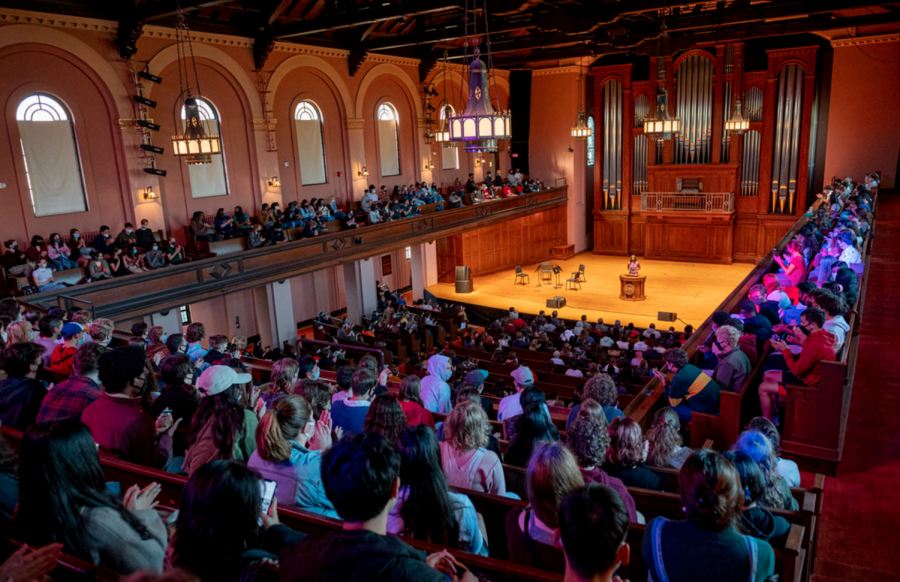Student Life Expands Capacity for Large First-Year Class
First-year students gather in Finney Chapel to listen to President Carmen Twillie Ambar’s welcome messages.
Last week, the College welcomed the class of 2025 to campus — one of the largest incoming classes in recent history. Programs across campus had to adapt to the 882 first-year students enrolled in order to support everyone on campus during the first week of in- person classes.
The class of 2025 had a particularly strong enrollment cycle with 10,636 student applicants. Admissions originally had a target to enroll 810 students but increased their goal to 870 after receiving this large applicant pool. The 882 first-years exceeded enrollment numbers from the past three years. The class of 2024 entered with 680 students, the class of 2023 with 807, and the class of 2022 with 818.
“Our larger applicant pool was extremely helpful, of course!” wrote Vice President and Dean of Admissions and Financial Aid Manuel Carballo in an email to the Review. “We are proud of the great virtual outreach we were able to conduct last year. … This has carried onto this next cycle with a very busy summer of campus visitors. We’ve seen a twofold increase in on-campus visitors in the summer months.”
One program that expanded this year to accommodate the first-years is the Peer Advising Leaders program. Student programming during the orientation period, facilitated largely by the PAL program, helped first- years acclimate to many of the hurdles associated with college life. This year, PAL expanded to 55 student PALs, which is ten more than last year.
The First-Year Seminar Program, another core aspect of the first-year experience, also had to expand to meet the large class size.
“We are offering 52 unique First-Year Seminars on an extraordinary range of topics, a significantly higher number than we have offered in the past,” wrote Associate Dean of the College of the Arts and Sciences and Director of the FYSP Elizabeth Hamilton in an email to the Review. “Credit is due to our Oberlin faculty — they know the great value of these first immersions in liberal arts learning and, as always, made it their priority to welcome this year’s large incoming class with just the right number of exceptionally well-designed seminars.”
For many students though, the most obvious repercussion of the large first-year class is the impact on housing. Many students wondered if this summer’s chaotic housing process, which included a last-minute request from Residential Education that third- and fourth-year students live off- campus, was a result of ResEd being stretched beyond their capacity.
However, according to Rebecca Mosely, director for Equity, Diversity, and Inclusion and recently appointed special assistant to the president for student housing, complications during the housing assignment process occurred due to uncertainty caused by COVID-19 and the condensed summer vacation. Mosely states that the large number of first-year students has not caused housing shortages, nor has it forced students to live in non-traditional housing. In fact, ResEd currently has openings in campus housing.
“What’s really interesting about this year [is that] we didn’t actually release that many more students off campus than we normally do,” Mosely said. “It just felt like it because of the late timing of the off-campus releases this year. So normally, in a non-COVID[-19] year, off-campus releases happen way earlier.”
A few students are being housed in The Hotel at Oberlin for reasons she could not disclose. However, the College was successful in finding housing for all other students in standard College housing or off-campus housing.
“We have a few students who are currently housed in the hotel, but that’s for some really kind of specific needs and reasons,” Mosely said. “We definitely ended up having space and being able to have people find locations off-campus that worked for them to be able to live, so we’re doing good right now.”
However, not all aspects of the move-in process went as smoothly. Many of the 76 first-year international students had to arrive early to meet the College’s requirement for unvaccinated international travelers to quarantine for seven days and for vaccinated international travelers to receive both a negative rapid and PCR test for COVID-19.
Josh Whitson, assistant dean of students and director of the International Student Resource Center, stressed that vaccines are still not available in some countries. Limited international flights also resulted in obscure, varied hours for arrivals. This, he says, created a more chaotic move-in process, especially for the first-year international students who had to quarantine.
“In many countries, it is still difficult to get vaccinated, so for any of those students that wanted to attend international orientation in person and not miss events like Connect Cleveland they had to scramble to change their travel plans if possible,” Whitson wrote in an email to the Review. “On top of all of this, about 60 sophomores had been entirely remote for the 2020 academic year, meaning this was their first time coming to campus and they needed a little more support than a typical returning student.”
In order to accommodate the number of students on campus, the College discontinued the ObieSafe housing policy that granted all students singles. The Office of Residential Education streamlined the housing process by maintaining the suspension of the standard lottery as well as the self- selection process for upperclassmen.







